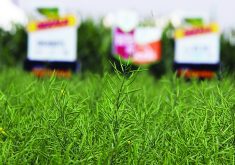The forgotten nutrient | Researchers say farmers need to keep an eye on phosphate levels before deficiencies develop
Terry Buss knows what to expect when his office phone rings in late July.
Buss, a Manitoba Agriculture farm production adviser in Beausejour, says soybean growers often call him in the third and fourth weeks of July because their crop is looking peculiar.
More often than not, the problem is potassium and phosphorus deficiencies in the soil.
A lack of potassium is easy to recognize because the edges of the plant leaves are burned or brown. However, spotting a phosphate shortage is more challenging.
Read Also

Growing garlic by the thousands in Manitoba
Grower holds a planting party day every fall as a crowd gathers to help put 28,000 plants, and sometimes more, into theground
“Getting phosphate deficiency symptoms that you can readily identify in soybeans is hard,” Buss said.
“I generally refer to it as crappy (beans)…. They just don’t look right.”
He said producers in eastern Manitoba have grown a rotation of soybeans, soybeans and more soybeans for years and chose not to apply phosphorus or potassium to the soil.
The beans, being excellent nutrient scavengers, hang on for seven or more years of continuous cropping before falling off a proverbial cliff, he added.
“They (beans) seem to give up the ghost when we’ve sucked every last pound (of nutrients), ” Buss said.
“They hold their condition and then you flip a switch and things start to go south.”
Few growers skimp on fertilizer applications for seven consecutive years, but soil fertility experts are disturbed by statistics that show prairie farmers are not applying sufficient amounts of phosphorus.
“Last year I gave 18 presentations, believe it or not, on the forgotten macronutrients, phosphorus being one of them,” said Rigas Karamanos, senior agronomist with Koch Fertilizer Canada.
“We’re putting a lot of emphasis on nitrogen … but phosphorus is something that we’ve kind of forgotten about.”
Karamanos decided to quantify the gap between phosphorus application and crop removal on the Prairies.
He used International Plant Nutrient Institute data on phosphorus removal per bushel and Statistics Canada acreage and crop yield data for Western Canada to estimate annual phosphorus removal.
For example, one bushel of barley removes .4 pounds of phosphorus, which means a 100 bu. per acre crop pulls 40 lb. per acre out of the soil.
Estimating the amount of applied phosphorus was trickier because the Canadian Fertilizer Institute posts fertilizer shipments to Western Canada but not the amount applied.
“Companies do not report what they sold, but they report what they shipped.”
Karamanos assumed the phosphorus shipped to Western Canada was sold and applied to crops.
He then calculated a dramatic gap between phosphorus application and removal on the Prairies.
“Last year there was 1,224,000 tonnes of phosphate applied, but there was 1.6 million (tonnes) removed,” he said.
Karamanos’ data shows that producers in Manitoba, Saskatchewan and Alberta applied less phosphorus than what the crops removed in every year since 2005. The cumulative nine-year deficit is 2.15 million tonnes.
Karamanos said the deficit isn’t shocking because two-year canola rotations are now commonplace and many farmers grow canola-canola-canola, which means the phosphorus removal is immense.
One bushel of canola removes .9 lb. of phosphorus, which means a 60 bu. crop removes 54 lb. of phosphorus.
“Who is supplying 54 lb.? Nobody. Twenty, 25 maybe,” Karamanos said.
“You look at those rotations of canola-wheat, they are removing an incredible amount of phosphorus…. We are taking advantage of what we’ve been applying the last 20 to 25 years, but we’re going to hit a (wall)…. We’re going to hit a point where we’ll not be able to get these big crops.”
Growers who called Buss weren’t sure what was wrong with their soybeans, but they knew something wasn’t right.
Soil samples and tissue tests helped him diagnose the malady: tight rotations or continuous soybeans drained nearly all of the phosphorus and severely depleted potassium levels.
“What we found with very, very tight soy rotations … it’s been very common … to not fertilize soy at all,” Buss said.
“That came out of an observation that on fertile soils, soy doesn’t really show a yield response to added potash or phosphate…. That was taken as, ‘well, we don’t need to do it.’ But I’ve got clients who have been doing that more than a decade and they’re not really adding it in at any other time in the rotation.”
Buss said problems with nutrient deficiency around Beausejour began on lighter textured soils, but the dearth of applied nutrients eventually hit producers with heavier clay soil.
Don Flaten, a soil science professor and phosphorus expert with the University of Manitoba, said research indicates crops suffer and crash when soil phosphorus is depleted, but it’s a rare occurrence in commercial crops.
“In many cases, the reserves are decent,” he said.
“It’s not an issue that is universally challenging producers…. Farm to farm and field to field, the situation is quite variable … (but) we can anticipate that these deficits will eventually catch up to us. The big question is when.”
An annual deficit of 20 lb. per acre might reduce the soil test phosphorus by one part per million. It means it could take 10 years to cut soil test phosphorus from 20 to 10 parts per million.
“The short-term consequences aren’t that obvious, but the long-term consequences are,” Flaten said.
Growers who apply little to no phosphorus will drain reserves more rapidly, but producers who follow the rules may also be depleting the system.
Flaten said average crop yields cause a 53 lb. per acre phosphorus deficit in four years when growers adhere to recommended rates of seed row phosphorus in a rotation of spring wheat, canola, winter wheat and soybeans.
Karamanos said the bottom line is basic: many growers aren’t applying enough phosphorus.
“We cannot get away with having wheat-canola-wheat-canola and putting down 20 lb. of phosphorus. You’re going to pay the price at the end.”
Flaten and fellow soil fertility experts John Heard of Manitoba Agriculture and Cindy Grant of Agriculture Canada recommend a fertility strategy that considers the entire crop rotation and adds extra phosphorus to cereal crops.
Producers are becoming more aware of the risks of phosphorus depletion and also more curious about manure, he said.
“They’ve become much more interested in the livestock manure in their neighbourhood,” he said.
“When they take a look at the cost of restoring their phosphorus fertility with commercial fertilizer … the livestock manure looks very, very attractive.”
Buss encourages growers to mind phosphorus levels, but he said he also understands the economic realities of agriculture. Soybeans have been and remain a lucrative crop, and farmers want to make money.
“I get paid every two weeks, so I can’t stand up, holier than thou, and say, ‘thou shalt not,’ ” he said.
“At the same time, there are limits to how far we can push this.”
He said he’s had many calls recently from growers inquiring about soil tests, possibly because they’ve heard horror stories about depleted phosphorus at the local coffee shop.
“The experience of some is benefitting the many.”


















